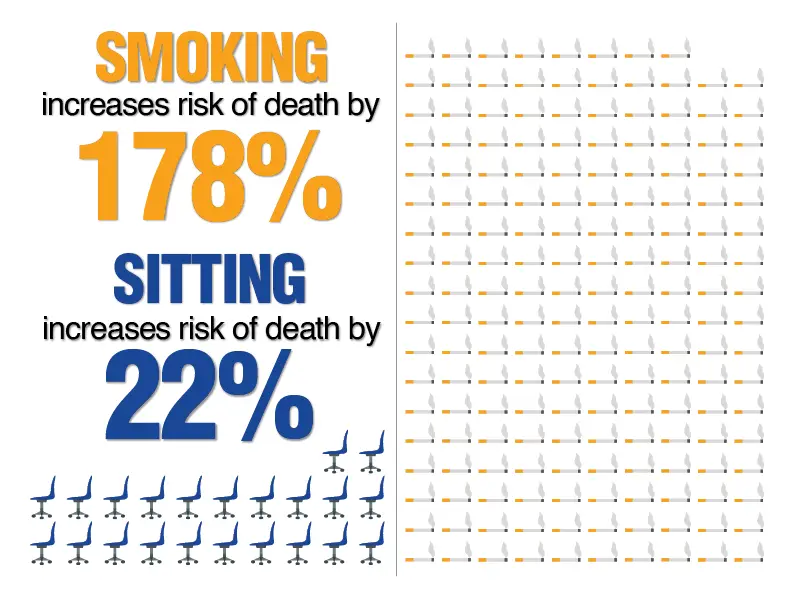It’s Monday again. I’m back in the saddle, like many of you, sitting and working on a typical Monday.
Modern life makes us sit. A lot. Which begs the question: Is sitting too long dangerous?

Some people claim “sitting is the new smoking.” Others disagree and downplay health risks associated with a sedentary lifestyle.
Who’s right? Just how dangerous is sitting?
Let’s explore 3 studies on the health risks of sitting, starting with the claim that “sitting is the new smoking.”
Sitting vs. Smoking
Cigarette smoking causes well-documented health risks. Smoking cigarettes is a surefire way to harm your lungs and shorten your lifespan.
Is sitting just as hazardous? Not quite…
Despite frightful claims that sitting and smoking are equally harmful, the science proves this isn’t true.
Smoking is far more dangerous than sitting.
A sedentary lifestyle (i.e. sitting too much) increases the risk of dying early by 22%. Not ideal, but not even close to the 178% risk of early death associated with smoking.
Is sitting too long dangerous compared to smoking? No, sitting is almost 10x safer!
Read more: Sitting vs. Smoking (The Truth)

Sitting and Dementia
Sitting and doing passive activities, like watching TV, is linked to elevated dementia risk in older adults.
In contrast, sitting and participating in activities (reading, scouring the internet, playing games) has a protective effect against dementia according to a 2022 study out of USC.
Scientists hypothesize that intellectual stimulation during engaging seated activities enhances cognitive function, reducing dementia risk.
Is sitting too long dangerous for dementia? It depends a lot on your chosen activities when you sit.

Sitting and Longevity
Genetics affect longevity, no doubt about it. But another recent study showed that behavior may be more important than genetics in determining how long we live.
Adults who sit less and exercise more tend to live longer, even if they don’t have “longevity” genes.
You can’t choose your parents. But you can choose to extend your lifespan by staying active.
If you’re new to exercise (or just getting back into it), learn how to build the habit with one of these 7 low-impact exercises.
Is sitting too long dangerous to longevity? It’s tough to quantify the exact risks for each person. However, research is clear that staying physically active extends lifespan.
Reduce the Risk
Many people have sedentary jobs (myself included). And sedentary hobbies (Netflix, reading, gaming, writing, etc.).
So what can we do to reduce the risks of sitting too much? And how much exercise is enough?
Scientists studied over 44,000 adults to answer this question. They concluded that exercising 30-40 minutes per day offsets the negative health risks of sitting.
The “exercise” in the study consisted of moderate-to-vigorous physical activity.
This research aligns closely with Physical Activity Guidelines from the American College of Sports Medicine (and the CDC).
The guidelines recommend at least 150 minutes of moderate intensity exercise per week. That’s 30 minutes per day, 5 days per week.

Alternatively, 75 minutes of vigorous exercise per week will suffice. Moderate intensity exercises include biking, hiking, gardening, golfing, pickleball and brisk walking.
Circuit training, running, soccer and basketball are considered vigorous exercises.
The guidelines also encourage resistance training at least twice per week, targeting the major muscle groups.
Sitting Articles
For more sitting-related reading, check out these articles:
Optimize your desk ergonomics to make sitting more comfortable for your back, neck and shoulders.
Overcome pain and stiffness from too much sitting – and look more confident – with these 5 strategies.
For more evidence-based health tips, join the free Facts & Physio Newsletter. Plus, get The Recovery Checklist when you sign up.


2 thoughts on “Is Sitting Too Long Dangerous to Your Health?”
Why is dry needling by physical therapists forbidden in California? Can medical doctors use it? Out-of-state family (Montana) use it regularly , consider it a miracle painkiller. Thank you for this extensive explanation ..I had not heard of it until today during telecon with family in Montana.
Barbara, unfortunately California is 1 of 6 states where physical therapists are forbidden to dry needle. It’s mainly a scope of practice issue; acupuncturists claim that dry needling is practicing acupuncture and that it infringes on their professional scope. Of course I disagree, and many states (including my home state of North Carolina) have ruled against acupuncturists on this issue. From what I’ve read online, only licensed acupuncturists and medical doctors can practice dry needling in CA.